本文记录C++并发与多线程的知识,介绍并发,线程的概念,并介绍在多线程场景下, lock(),unlock(), unique_lock()和lock_guard()的使用。本章一共16节,本文记录1-6节。
文章目录
- [第13章 C++11 并发与多线程](#第13章 C++11 并发与多线程)
-
- [13.1 并发基本概念及实现,进程、线程基本概念](#13.1 并发基本概念及实现,进程、线程基本概念)
-
- [13.1.1 并发,进程,线程基本概念](#13.1.1 并发,进程,线程基本概念)
-
- [13.1.1.1. 并发概念](#13.1.1.1. 并发概念)
- [13.1.1.2. 可执行程序](#13.1.1.2. 可执行程序)
- [13.1.1.3. 进程](#13.1.1.3. 进程)
- [13.1.1.4. 线程](#13.1.1.4. 线程)
- [13.1.2 并发的实现方法](#13.1.2 并发的实现方法)
- [13.1.3 C++11新标准](#13.1.3 C++11新标准)
- [13.2 线程创建,开始及结束-线程用法:join,detach](#13.2 线程创建,开始及结束-线程用法:join,detach)
-
- [13.2.1 创建一个线程](#13.2.1 创建一个线程)
- [13.2.2 thread,join(), joinable()](#13.2.2 thread,join(), joinable())
- [13.2.3 detach() 分离主线程](#13.2.3 detach() 分离主线程)
- [13.2.4 子线程和主线程的内存关系](#13.2.4 子线程和主线程的内存关系)
- [13.2.5 使用detach()方法,传递引用存在的问题](#13.2.5 使用detach()方法,传递引用存在的问题)
- [13.3 线程传参解,detach坑,成员函数做线程函数](#13.3 线程传参解,detach坑,成员函数做线程函数)
-
- [13.3.1 detach()下,传递临时对象作为线程参数](#13.3.1 detach()下,传递临时对象作为线程参数)
-
- [13.3.1.1 要避免的陷阱:主线程资源被回收](#13.3.1.1 要避免的陷阱:主线程资源被回收)
- [13.3.1.2 给线程传递临时对象构造时机](#13.3.1.2 给线程传递临时对象构造时机)
- [13.3.1.3 获取线程id的方式](#13.3.1.3 获取线程id的方式)
- [13.3.1.4 使用引用,为什么多了一次拷贝构造](#13.3.1.4 使用引用,为什么多了一次拷贝构造)
- [13.3.2 用成员函数指针做线程函数](#13.3.2 用成员函数指针做线程函数)
- [13.4 创建多个线程、数据共享问题分析、案例代码](#13.4 创建多个线程、数据共享问题分析、案例代码)
-
- [13.4.1 创建和等待多个线程](#13.4.1 创建和等待多个线程)
- 13.4.2数据共享问题
-
- [13.4.2.1 只读的数据](#13.4.2.1 只读的数据)
- [13.4.2.2 有读有写数据](#13.4.2.2 有读有写数据)
- [13.4.3 其他案例](#13.4.3 其他案例)
- [13.5 互斥量概念、用法、死锁演示及解决详解](#13.5 互斥量概念、用法、死锁演示及解决详解)
-
- [13.5.1 互斥量mutex概念--保护共享数据](#13.5.1 互斥量mutex概念--保护共享数据)
- [13.5.2 互斥量用法 + lock_guard](#13.5.2 互斥量用法 + lock_guard)
-
- [13.5.2.1 lock() 和 unlock() 成对使用](#13.5.2.1 lock() 和 unlock() 成对使用)
- [13.5.2.2 lock_guard() 自动解锁](#13.5.2.2 lock_guard() 自动解锁)
- [13.5.3 死锁](#13.5.3 死锁)
-
- [13.5.3.1 不发生死锁代码](#13.5.3.1 不发生死锁代码)
- [13.5.3.2 发生死锁代码](#13.5.3.2 发生死锁代码)
- [13.5.4 lock_guard的使用](#13.5.4 lock_guard的使用)
- [13.6 unique_lock详解](#13.6 unique_lock详解)
-
- [13.6.1 unique_lock() 取代 lock_guard](#13.6.1 unique_lock() 取代 lock_guard)
- [13.6.2 unique_lock的第二个参数](#13.6.2 unique_lock的第二个参数)
-
- [13.6.2.1 adopt_lock](#13.6.2.1 adopt_lock)
- [13.6.2.2 try_to_lock()与owns_lock()配合使用](#13.6.2.2 try_to_lock()与owns_lock()配合使用)
- [13.6.2.3 defer_lock()](#13.6.2.3 defer_lock())
- [13.6.2.4 线程休眠的写法](#13.6.2.4 线程休眠的写法)
- [13.6.3 unique的成员函数](#13.6.3 unique的成员函数)
-
- [13.6.3.1 lock() 和unlock() 粒度](#13.6.3.1 lock() 和unlock() 粒度)
- [13.6.3.2 try_lock()](#13.6.3.2 try_lock())
- [13.6.3.3 release()](#13.6.3.3 release())
- [13.6.4 unique_lock所有权传递](#13.6.4 unique_lock所有权传递)
第13章 C++11 并发与多线程
13.1 并发基本概念及实现,进程、线程基本概念
13.1.1 并发,进程,线程基本概念
13.1.1.1. 并发概念
对于单核CPU,某时刻只能执行一个任务,但是每秒钟进行多次操作系统调度,这就是并发。并发的主要目的就是提高性能。
13.1.1.2. 可执行程序
是硬盘上保存的一个文件,windows下.exe linux a.out 具有可执行权限的程序。
13.1.1.3. 进程
可执行程序运行起来后,就是进程。
13.1.1.4. 线程
a) 每个进程都有一个主线程。进程启动后,主线程就启动了;进程的主线程来执行main()中的代码;当主线程执行完毕main中代码后,表示整个进程就执行完毕了。
c) 创建其他线程。创建的线程去执行其他代码。
d) 多线程的开销。多个线程并发执行,每个线程消耗1M独立的堆栈空间,而且线程切换要保存很多中间状态。所以线程不能太多,否则线程的切换会消耗本该属于其他线程的时间,降低效率。
e) 至于一个进程要创建多少个线程,很难评估和量化,需要在实际应用中调整和优化。
13.1.2 并发的实现方法
两种方法实现并发,多进程和多线程,推荐使用多线程。
在单独的进程中,创建多个线程实现并发。每个进程中的所有线程,共享内存;多线程的切换开销远远小于进程,但是共享内存带来新问题,数据一致性问题。
线程的开销小于进程的开销。
13.1.3 C++11新标准
C++11 支持了多线程,支持跨平台。
13.2 线程创建,开始及结束-线程用法:join,detach
- 程序运行起来后,生成了一个进程,进程的主线程自动运行。
- 主线程和次线程的开始和结束。主线程从main() 开始执行,次线程从绑定的函数开始执行,函数执行完毕后,次线程也就执行完了。
- 进程结束标志。 进程中的主线程执行完毕了,该进程就执行完毕了。如果其他线程还没有执行完毕,那么这些子线程会被强制终止。所以,一般情况下,想保持子线程的运行状态的话,那么就让主线程一直保持运行,不要让主线程退出。
13.2.1 创建一个线程
C++ 中使用 thread 创建一个线程。
cpp
void myPrint()
{
cout << "新线程开始执行1" << endl;
cout << "新线程开始执行2" << endl;
cout << "新线程开始执行3" << endl;
cout << "新线程开始执行4" << endl;
cout << "新线程开始执行5" << endl;
cout << "新线程结束执行" << endl;
}
void test ()
{
thread myobj(myPrint);
myobj.join(); // 阻塞主线程,阻塞到这里,当子线程执行完毕,主线程继续往下走。
if (myobj.joinable())
{
cout << " true" << endl;
}
else
{
cout << " false" << endl;
}
}13.2.2 thread,join(), joinable()
- thread 是线程类,thread myObj就是类实例化的对象。
2 myPrint() 是次线程入口函数,次线程进入该函数开始,执行完该函数后,次线程结束。
3 join()就是阻塞主线程,等待所有次线程执行完毕后,再执行主线程。
4 joinable () 判断当前线程对象,是否可以使用join()方法;可以则返回true,否则返回false;
13.2.3 detach() 分离主线程
让主线程和次线程分离,那么次线程的资源由运行时库接管,接管之后,次线程的资源的释放工作由运行时库负责。
注意:detach() 之后就不能再使用 join()了。
cpp
thread myobj(myPrint);
myobj.join(); // 阻塞主线程,阻塞到这里,当子线程执行完毕,主线程继续往下走。
if (myobj.joinable())
{
cout << " true" << endl;
}
else
{
cout << " false" << endl;
}当一个线程被分离(detach)后,就不能再对这个线程执行任何操作,也不能获取该线程的返回值,其生命周期就由C++运行时库自动管理了,当线程执行完毕后,运行库自动清理这个线程所使用的所有资源,包括线程的堆栈和内核资源。
当进程退出,也就是main()执行完毕,这个被分离的线程不论是否执行完毕,都会被释放。
13.2.4 子线程和主线程的内存关系
在C++中,主线程和子线程共享进程的地址空间,这意味着它们可以访问相同的全局变量和堆内存。然而,每个线程都有自己的栈内存,所以局部变量和函数参数在不同的线程之间是隔离的。
这种内存模型有一些重要的含义:
- 全局变量和堆内存:因为主线程和子线程共享全局变量和堆内存,所以一个线程可以修改另一个线程可以看到的数据。所以对于共享的数据,应该使用同步机制,比如使用互斥量(std::mutex)、条件变量(std::condition_variable)或其他同步原语来确保线程安全地访问共享数据。
- 栈内存:线程的栈空间类似于函数的栈栈空间,出作用于就会被析构。所以,在外部使用线程的栈空间地址。可以在线程中使用堆内存,开辟堆内存并返回。
- 线程局部存储:C++还提供了线程局部存储(Thread Local Storage,TLS),这是一种特殊类型的存储,每个线程都有自己的一份。你可以使用thread_local关键字来声明线程局部变量。这些变量在每个线程中都是唯一的,即使它们的名称和类型在所有线程中都是相同的。
下面的例子,主线程创建了子线程,子线程复制了主线程的类的对象,次线程调用
拷贝构造函数重新复制一份,然后次线程结束后,析构;
但是线程的拷贝是浅拷贝,需要在类中实现拷贝构造函数的深拷贝。
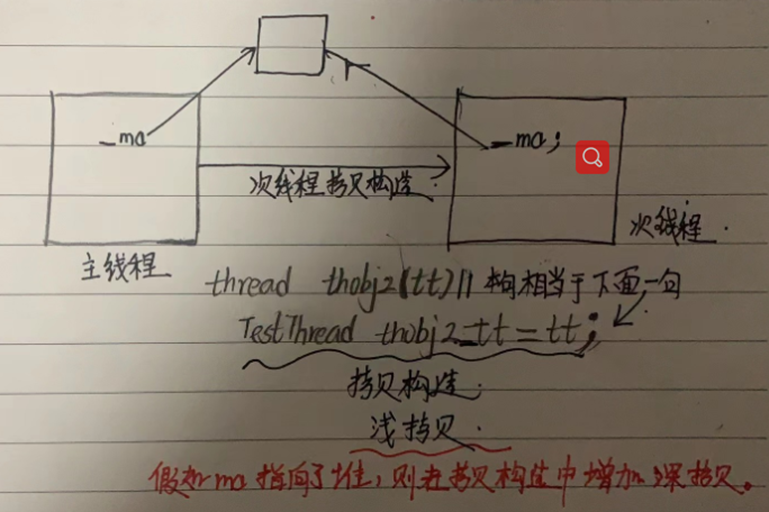
cpp
class TestThread
{
public:
explicit TestThread(int& i) :m_a(i)
{
cout << "构造函数执行 this " << this << " m_a = " << m_a << endl;
}
TestThread(const TestThread& obj) :m_a(obj.m_a)
{
cout << "拷贝构造函数执行 this " << this << " m_a = " << m_a << endl;
}
~TestThread()
{
cout << "析构函数执行 this " << this << " m_a = " << m_a << endl;
}
void operator()(int j)
{
cout << "------新线程开始执行1" << endl;
cout << "------新线程结束执行1" << endl;
}
private:
int &m_a;
};
void test02()
{
cout << "====主线程开始========" << endl;
int mj = 2;
TestThread obj(mj); // explicit TestThread(int& i) :m_a(i)
thread t(obj, 2); // TestThread(const TestThread& obj) :m_a(obj.m_a)
if (t.joinable()) // 线程的析构函数执行
{
t.join();
}
else
{
cout << "detached" << endl;
}
cout << "====主=线程结束========" << endl; // 主线程的析构函数执行
}
如果给次线程传递函数是operator() ,传递一个对象,那么在线程中会调用拷贝构造函数重新生成一个对象。也就是传递对象时,主线程和次线程独享对象空间。
13.2.5 使用detach()方法,传递引用存在的问题
使用detach() + 对象传递引用后,因为主线程执行完毕后,主线程被析构,所以,主线程中的mj = 4被析构。
cpp
class TestThread
{
public:
TestThread(int &i) :_ma(i)
{
cout << "this " << this << " TestThread(int &i)" << endl;
}
TestThread(const TestThread & obj):_ma(obj._ma)
{
cout << "this " << this << " TestThread(const TestThread & obj)" << endl;
}
~TestThread()
{
cout << "this " << this << "~TestThread()" << endl;
}
void operator()()
{
cout << "----新线程开始执行1 " << _ma << endl;
cout << "新线程开始结束2---- " << _ma << endl;
cout << "新线程开始结束3---- " << _ma << endl;
cout << "新线程开始结束4---- " << _ma << endl;
cout << "新线程开始结束5---- " << _ma << endl;
cout << "新线程开始结束6---- " << _ma << endl;
}
private:
int &_ma;
};
void test3()
{
int mj = 4;
TestThread tt(mj);
thread thobj2(tt);
thobj2.detach();
}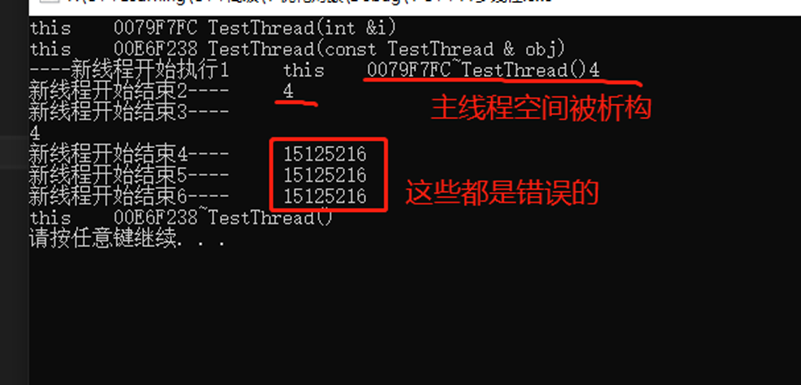
13.3 线程传参解,detach坑,成员函数做线程函数
13.3.1 detach()下,传递临时对象作为线程参数
13.3.1.1 要避免的陷阱:主线程资源被回收
下边这段代码,本希望将char数组 mybuf 自动转为string ,传递给线程函数,但是什么时候转呢?通过验证,存在主线程执行完毕后才会转,这时候,主线程中的mybuf已经被回收了。
结论:在给线程传递的对象需要隐士转换时候,一定要显示转换再传递。
原始代码
cpp
void myprint(const int i, const string &pmybuf)
{
cout << i << endl;
cout << pmybuf.c_str() << endl;
return;
}
void test4()
{
int mvar = 1;
// int &mvary = mvar;
char mybuf[] = "this is a test!";
thread myobj(myprint, mvar, mybuf);
myobj.detach();
cout << "T love China!" << endl;
}修改后
将传递的参数,转为临时对象传递给线程函数。
cpp
void test4()
{
// 一 传递临时对象作为线程参数
// 1.1 要避免的陷阱
int mvar = 1;
// int &mvary = mvar;
char mybuf[] = "this is a test!";
// thread myobj(myprint, mvar, mybuf); // 错误方式
thread myobj(myprint, mvar, string(mybuf)); // 这里将mybuf转换为 stirng对象,保证了线程安全
myobj.detach();
cout << "T love China!" << endl;
}验证:传递临时对象在次线程函数中构造
结论:主线程给次线程传递的参数为引用时候,并不会按引用传递。在次线程中又会调用拷贝构造函数,生成一份新的对象。
cpp
// 线程函数中的引用i是值传递
class A
{
public:
A(int a) :_mi(a) { cout << "this " << this << " 函数执行 " << "tid " << std::this_thread::get_id() << endl; }
~A() { cout << "this " << this << " 析构函数执行 " << "tid " << std::this_thread::get_id() << endl; }
A(const A &src):_mi(src._mi)
{
cout << "this " << this << " copy构造函数执行 " << "tid " << std::this_thread::get_id() << endl;
}
private:
int _mi;
};
void ThreadFunc2(const A & src)
{
cout << &src << " tid " << std::this_thread::get_id() << endl;
}
void test5()
{
int i = 2;
thread mythd(ThreadFunc2, i);
mythd.join();
return;
}
int main()
{
test5();
system("pause");
return 1;
}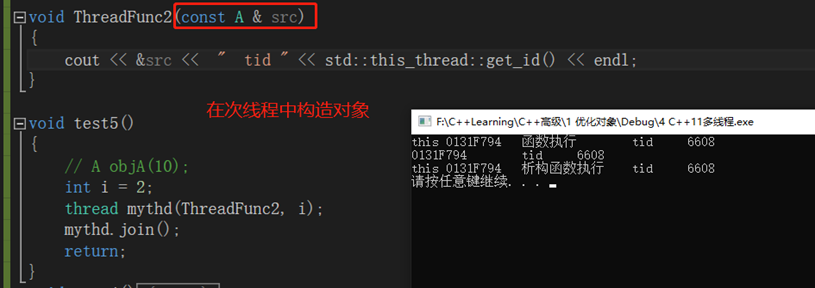
验证:主线程给次线程传递对象的引用,在次线程中会生成新对象吗?
结论:虽然传递引用,但是次线程并不会按照引用传递,相当于值传递,生成了一份新对象.
cpp
class A
{
public:
A(int a) :_mi(a)
{
cout << "this " << this << " 构造函数执行 " << "tid " << std::this_thread::get_id() << endl;
}
~A()
{
cout << "this " << this << " 析构函数执行 " << "tid " << std::this_thread::get_id() << endl;
}
A(const A& src) :_mi(src._mi)
{
cout << "this " << this << " copy构造函数执行 " << "tid " << std::this_thread::get_id() << endl;
}
private:
mutable int _mi;
};
void ThreadFunc2(const A& src)
{
cout << &src << " tid " << std::this_thread::get_id() << endl;
}
void test()
{
A objA(10);
int i = 2;
thread mythd(ThreadFunc2, objA);
mythd.join();
return;
}
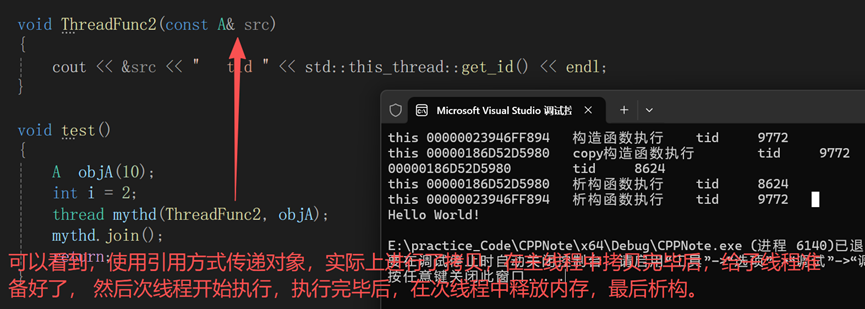
验证:使用std::ref传递真引用
结论:如果要在线程中传递引用,需要使用std::ref, 传递引用。
cpp
class A
{
public:
A(int a) :_mi(a)
{
cout << "this " << this << " 构造函数执行 " << "tid " << std::this_thread::get_id() << endl;
}
~A()
{
cout << "this " << this << " 析构函数执行 " << "tid " << std::this_thread::get_id() << endl;
}
A(const A& src) :_mi(src._mi)
{
cout << "this " << this << " copy构造函数执行 " << "tid " << std::this_thread::get_id() << endl;
}
private:
mutable int _mi;
};
void ThreadFunc2(const A& src)
{
cout << &src << " tid " << std::this_thread::get_id() << endl;
}
void test()
{
A objA(10);
int i = 2;
thread mythd(ThreadFunc2, std::ref(objA));
mythd.join();
return;
}
13.3.1.2 给线程传递临时对象构造时机
结论:传递临时对象,可以保证在主线程中构造对象,并传递给次线程,保证了安全。

传递临时对象流程:在主线程中生成临时对象,然后调用拷贝构造函数,给次线程准备好执行环境;然后次线程执行完毕后,调用析构函数,析构掉次线程中的对象;然后主线程也调用析构,析构掉主线程中的对象。
cpp
// 线程函数中的引用i是值传递,
class A
{
public:
A(int a) :_mi(a)
{
cout << "this " << this << " 构造函数执行 " << "tid " << std::this_thread::get_id() << endl;
}
~A()
{
cout << "this " << this << " 析构函数执行 " << "tid " << std::this_thread::get_id() << endl;
}
A(const A& src) :_mi(src._mi)
{
cout << "this " << this << " copy构造函数执行 " << "tid " << std::this_thread::get_id() << endl;
}
private:
mutable int _mi;
};
void ThreadFunc2(const A& src)
{
cout << &src << " tid " << std::this_thread::get_id() << endl;
}
void test()
{
int i = 2;
thread mythd(ThreadFunc2, A(10));
mythd.join();
// 传递临时对象
}

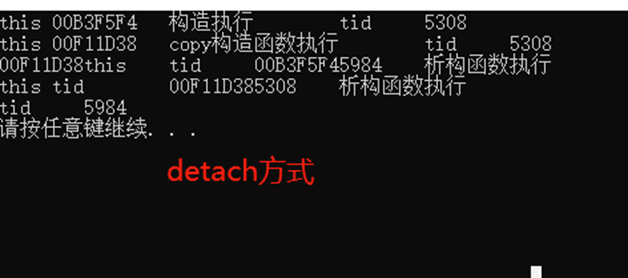
13.3.1.3 获取线程id的方式
cpp
std::this_thread::get_id()13.3.1.4 使用引用,为什么多了一次拷贝构造
理解:C++为了安全,在引用这里又生成了一个对象。
在传递对象时候,可以使用std::ref,传递的是真正的引用。
13.3.2 用成员函数指针做线程函数
结论:使用成员函数指针作为线程的函数,除了传递函数指针外,还需要传递对象的地址。

cpp
class A
{
public:
A(int a) :_mi(a)
{
cout << "this " << this << " 构造函数执行 " << "tid " << std::this_thread::get_id() << endl;
}
~A()
{
cout << "this " << this << " 析构函数执行 " << "tid " << std::this_thread::get_id() << endl;
}
A(const A& src) :_mi(src._mi)
{
cout << "this " << this << " copy构造函数执行 " << "tid " << std::this_thread::get_id() << endl;
}
void fun()
{
cout << "fun 成员函数 执行了 " << std::this_thread::get_id() << endl;
}
private:
mutable int _mi;
};
void ThreadFunc2(const A& src)
{
cout << &src << " tid " << std::this_thread::get_id() << endl;
}
void test()
{
A objA(10);
int i = 2;
thread mythd2(&A::fun, &objA);
mythd2.join();
return;
}13.4 创建多个线程、数据共享问题分析、案例代码
13.4.1 创建和等待多个线程
用vector数组存放10个线程,线程的入口函数相同。
执行下面的代码,出现如下问题:
- 多个线程执行顺序是乱的,这是操作系统调度器有关;
- 主线程等待子线程结束,最后主线程结束,使用了join()方法,更容易写出稳定的程序。
- 把thread对象放在容器中,thread数组,对创建大量的线程并对大量线程管理很方便。
cpp
void myprint(int num)
{
cout << "myprint num = " << num << endl;
}
void test()
{
//1 创建和等待多个线程
vector<thread> mythreads;
// 创建10个线程,线程入口函数统一使用myprint1
for (int i = 0; i < 10; ++i)
{
// thread t(myprint1,i);
mythreads.push_back(std::thread(myprint, i)); // 创建并开始执行10个线程
}
// 主线程等待10个线程
for (auto it = mythreads.begin(); it != mythreads.end(); ++it)
{
it->join();
}
cout << "I love China" << endl;
}
13.4.2数据共享问题
13.4.2.1 只读的数据
创建10个线程,线程入口函数统一使用 myprint,创建并开始执行10个线程,这10个线程只读全局数据。
结论:10个线程都去读,不会出现问题。
cpp
vector<int> vec{ 1,2,3 };
void myprint(int num)
{
cout << "num = " << num << "," << vec[0] << "," << vec[1] << "," << vec[2] << "," << endl;
}
void test()
{
//1 创建和等待多个线程
vector<thread> mythreads;
// 创建10个线程,线程入口函数统一使用myprint1
for (int i = 0; i < 10; ++i)
{
// thread t(myprint1,i);
mythreads.push_back(std::thread(myprint, i)); // 创建并开始执行10个线程
}
// 主线程等待10个线程
for (auto it = mythreads.begin(); it != mythreads.end(); ++it)
{
it->join();
}
}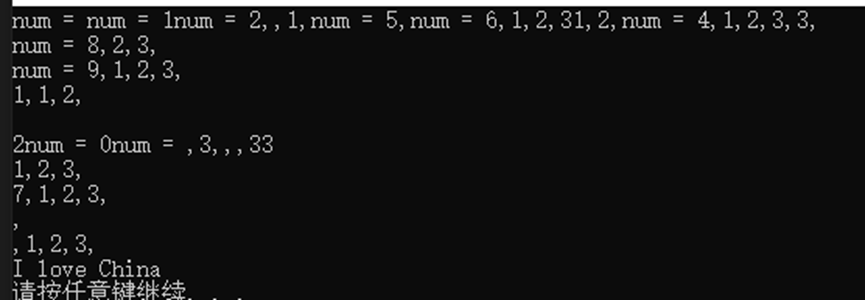
13.4.2.2 有读有写数据
假如一共10个线程,2个写线程,8个读线程,如果不进行特别处理,程序会崩溃;
最简单的解决办法是:读时不写,写时不读。
下面的代码说明:如果读线程,不加empty()判断,程序会崩溃,如果加了empty()判空,条件满足,程序不会出现问题。
下面程序加了 empty() 也会出现问题。
修改方式见下节:
cpp
class TestLock
{
public:
// 存数据
void inMessageQueue()
{
for (int i = 0; i < 10000; ++i)
{
cout << "i 入队列 " << i << endl;
m_listRecMessage.push_back(i);
}
}
void outMessageQueue()
{
for (int i = 0; i < 10000; ++i)
{
if (!m_listRecMessage.empty())
{
int command = m_listRecMessage.back();
cout << "i 出队列了 " << command << endl;
m_listRecMessage.pop_back();
}
}
}
private:
list<int> m_listRecMessage; // 链表
mutex m_mutex;
};
void test()
{
TestLock testLock;
thread t1(&TestLock::inMessageQueue, &testLock);
thread t2(&TestLock::outMessageQueue, &testLock);
t1.join();
t2.join();
}
上面的程序,只有写入线程在执行,而读出线程不执行。
13.4.3 其他案例
火车票例子:北京---深圳,火车站10个卖票窗口,1,2号窗口同时定99号座位,如果同时都买,出错!
解决方法: 假如1号订座位时候,2号窗口等着,直到1号窗口订票完毕,2号才能订。
13.5 互斥量概念、用法、死锁演示及解决详解
13.5.1 互斥量mutex概念--保护共享数据
保护数据共享:操作共享数据时候,先锁住,使用完毕,再解锁,这种锁机制就是互斥量。
互斥量是个类对象,对象.lock()方法,多个线程只有一个线程能lock()成功。如果锁成功,就执行下面的代码;如果锁失败,那么流程卡在lock(),不断尝试去Lock()。
13.5.2 互斥量用法 + lock_guard
13.5.2.1 lock() 和 unlock() 成对使用
使用步骤:lock() 操作共享数据, unlock()
下面的代码使用了互斥量,可以解决线程读写共享内存的问题。
cpp
class CReadWrite
{
public:
void inMsgRecvQue()
{
for (int i = 0; i < 10; ++i)
{
mymutex.lock();
RecMessage.emplace_back(i);
cout << "input i = " << i << endl;
mymutex.unlock();
}
}
bool outMsgFunc(int& command)
{
mymutex.lock();
if (!RecMessage.empty())
{
command = RecMessage.front();
RecMessage.pop_front();
mymutex.unlock();
return true;
}
else
{
mymutex.unlock();
return false;
}
}
void outMsgRecQue()
{
int command = 0;
bool flag = false;
for (int i = 0; i < 10; ++i)
{
flag = outMsgFunc(command);
if (flag)
{
cout << "output = " << command << endl;
}
else
{
cout << "队列为空 " << endl;
}
}
}
private:
list<int> RecMessage;
mutex mymutex;
};
int test()
{
CReadWrite objC;
thread t1(&CReadWrite::inMsgRecvQue, &objC);
thread t2(&CReadWrite::outMsgRecQue, &objC);
t1.join();
t2.join();
return 0;
}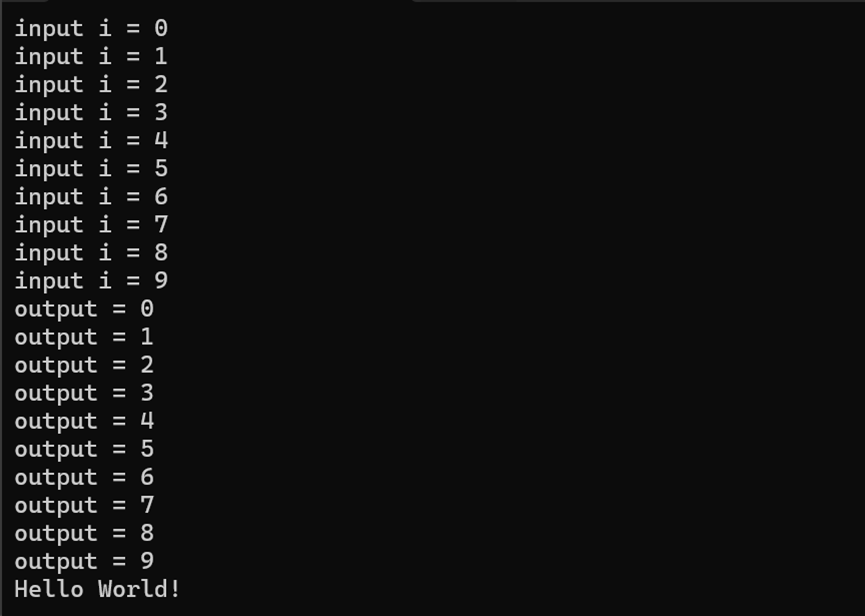
13.5.2.2 lock_guard() 自动解锁
lock和unlock()成对使用,但是为了防止unlock(),引入了std::lock_guard()类模板。原理是:lock_guard 构造时候执行 lock() ; 析构时候,执行 unlock()。
cpp
class CReadWrite
{
public:
void inMsgRecvQue()
{
cout << "insert begin " << endl;
for (int i = 0; i < 10000; ++i)
{
//mymutex.lock();
lock_guard<mutex> lg(mymutex);
RecMessage.emplace_back(i);
cout << "input i = " << i << endl;
// mymutex.unlock();
}
cout << "insert end " << endl;
}
bool outMsgFunc(int& command)
{
lock_guard<mutex> lg(mymutex);
//mymutex.lock();
if (!RecMessage.empty())
{
command = RecMessage.front();
RecMessage.pop_front();
//mymutex.unlock();
return true;
}
else
{
//mymutex.unlock();
return false;
}
}
void outMsgRecQue()
{
cout << "takeout begin " << endl;
int command = 0;
bool flag = false;
for (int i = 0; i < 10000; ++i)
{
flag = outMsgFunc(command);
if (flag)
{
cout << "command = " << command << endl;
}
else
{
cout << "队列为空 " << endl;
}
}
cout << "takeout end " << endl;
}
private:
list<int> RecMessage;
mutex mymutex;
};13.5.3 死锁
死锁前提条件:1 有两个线程,2 每个线程都要锁两把锁,分别是金锁和银锁,
这两个线程执行操作,
不发生死锁的情况是:
A线程:金锁,银锁;
B线程:金锁,银锁。
A线程锁金锁后,即使进行上下文切换,B线程也开始所金锁,由于A线程已经锁住,所以B线程无法再次锁金锁,进行上下文切换,再次切换到A进程,A进程就可以锁银锁了。然后A就可以工作了。执行完毕A后,分别解开金锁和银锁,线程A就执行完毕了,线程B就可以成功上金锁,银锁了,上边的过程不存在发生死锁的情况。
发生死锁的情况:
A线程: 金锁,银锁;
B线程: 银锁,金锁;
分析:A线程锁金锁后,开始锁银锁;假如此时进行上下文切换,B线程开始执行,这是B开始锁银锁,然后尝试锁金锁,由于金锁已经被A线程锁住,所以B就不发成功锁金锁,线程B的CPU时间完毕后,切换到A线程。A线程开始锁银锁,但是银锁已经被B锁住,A也只好等待B解开银锁后,再上银锁;而B只好等待A处理完毕后,再次上金锁。两个线程处于这样的僵持状态,就是死锁。
13.5.3.1 不发生死锁代码
两个线程加锁的顺序相同。
cpp
class CReadWrite
{
public:
void inMsgRecvQue()
{
for (int i = 0; i < 10; ++i)
{
mymutex1.lock();
mymutex2.lock();
RecMessage.emplace_back(i);
cout << "input i = " << i << endl;
mymutex1.unlock();
mymutex2.unlock();
}
}
bool outMsgFunc(int& command)
{
mymutex1.lock();
mymutex2.lock();
if (!RecMessage.empty())
{
command = RecMessage.front();
RecMessage.pop_front();
mymutex1.unlock();
mymutex2.unlock();
return true;
}
else
{
mymutex1.unlock();
mymutex2.unlock();
return false;
}
}
void outMsgRecQue()
{
int command = 0;
bool flag = false;
for (int i = 0; i < 10; ++i)
{
flag = outMsgFunc(command);
if (flag)
{
cout << "command = " << command << endl;
}
else
{
cout << "队列为空 " << endl;
}
}
}
private:
list<int> RecMessage;
mutex mymutex1;
mutex mymutex2;
};
void test()
{
CReadWrite myCReadWrite;
std::thread t1(&CReadWrite::inMsgRecvQue, &myCReadWrite);
std::thread t2(&CReadWrite::outMsgRecQue, &myCReadWrite);
t1.join();
t2.join();
}13.5.3.2 发生死锁代码
写线程加锁顺序:锁2和锁1;读线程加锁顺序,锁1和锁2。
cpp
class CReadWrite
{
public:
void inMsgRecvQue()
{
cout << "insert begin " << endl;
for (int i = 0; i < 1000; ++i)
{
mymutex2.lock();
mymutex1.lock();
RecMessage.emplace_back(i);
cout << "input i = " << i << endl;
mymutex1.unlock();
mymutex2.unlock();
}
cout << "insert end " << endl;
}
bool outMsgFunc(int& command)
{
mymutex1.lock();
mymutex2.lock();
if (!RecMessage.empty())
{
command = RecMessage.front();
RecMessage.pop_front();
mymutex1.unlock();
mymutex2.unlock();
return true;
}
else
{
mymutex1.unlock();
mymutex2.unlock();
return false;
}
}
void outMsgRecQue()
{
cout << "takeout begin " << endl;
int command = 0;
bool flag = false;
for (int i = 0; i < 1000; ++i)
{
flag = outMsgFunc(command);
if (flag)
{
cout << "command = " << command << endl;
}
else
{
cout << "队列为空 " << endl;
}
}
cout << "takeout end " << endl;
}
private:
list<int> RecMessage;
mutex mymutex1;
mutex mymutex2;
};只要线程A或者线程B加金锁和银锁的顺序发生变化,就会发生死锁。
13.5.4 lock_guard的使用
用两个 lock_guard 管两个互斥量时,如果构造用的是 std::adopt_lock,必须先用 std::lock(m1, m2) 把它们"同时"加锁,再用 lock_guard 接管所有权。
std::lock(m1, m2) 会一次性以无死锁算法获取多个互斥量,返回时二者均已上锁。
std::adopt_lock 的作用是"采用已有锁":告诉 lock_guard/unique_lock 构造函数,此互斥量已经被当前线程锁住了,构造时不要再加锁,只负责在析构时解锁。若传了 adopt_lock 但实际上没有先锁住,会导致未定义行为。
cpp
class A
{
public:
// 把收到的消息入到一个队列的线程
void inMsgRecvQueue()
{
for (int i = 0; i < 10; i++)
{
lock(mytex1, mytex2);
lock_guard<mutex> guard1(mytex1, std::adopt_lock);
lock_guard<mutex> guard2(mytex2, std::adopt_lock);
cout << "In = " << i << endl;
msgRecvQueue.push_back(i); // 收到10000个数据
}
}
bool outMsgFunc(int& command)
{
mytex1.lock();
mytex2.lock();
if (!msgRecvQueue.empty())
{
//
command = msgRecvQueue.front(); // 取出元素
msgRecvQueue.pop_front();
mytex1.unlock();
mytex2.unlock();
return true;
// 这里考虑处理数据
}
else
{
cout << "消息队列是空" << endl;
mytex1.unlock();
mytex2.unlock();
return false;
}
}
// 把数据从消息队列中取出
void outMsgRecQueue()
{
int command = 0;
bool result = false;
for (int i = 0; i < 10; i++)
{
result = outMsgFunc(command);
if (result == true)
{
cout << "Out = " << command << endl;
}
}
}
private:
list<int> msgRecvQueue;
mutex mytex1;
mutex mytex2;
};
void test()
{
A objC;
thread t1(&A::inMsgRecvQueue, &objC);
thread t2(&A::outMsgRecQueue, &objC);
t1.join();
t2.join();
}13.6 unique_lock详解
13.6.1 unique_lock() 取代 lock_guard
unique_lock是个类模板,工作中一般使用lock_guard(推荐使用,因为Lock_guard效率更高);lock_guard取代了mutex的lock和unlock(构造中lock(),析构时unlock() )
在使用上,unique_lock() 和 lock_guard() 效果完全一样。
cpp
lock(mytex2, mytex1);
unique_lock<mutex> unique(mytex1, std::adopt_lock);
unique_lock<mutex> unique2(mytex2, std::adopt_lock);注意: unique_lock 可以随时手动调用 unlock()解锁,不用非要得析构时解锁。
13.6.2 unique_lock的第二个参数
13.6.2.1 adopt_lock
lock_guard中,adopt_lock 表示这个互斥量已经被Lock()了,不需要再次lock()了,只需要在析构函数中 unlock() mutex即可。
cpp
class A06_1
{
public:
// 把收到的消息入到一个队列的线程
void inMsgRecvQueue()
{
for (int i = 0; i < 1000; i++)
{
//mytex.lock();
mytex1.lock();
unique_lock<mutex> guard1(mytex1, std::adopt_lock);
//mytex1.lock();
//mytex2.lock();
cout << "In = " << i << endl;
msgRecvQueue.push_back(i); // 收到10000个数据
//mytex.unlock();
//mytex1.unlock();
//mytex2.unlock();
}
}
bool outMsgFunc(int & command)
{
//mytex.lock();
mytex1.lock();
unique_lock<mutex> guard1(mytex1, std::adopt_lock);
// 当休息20秒,导致了 In也被卡20秒
// std::chrono::milliseconds dura(20000);
if (!msgRecvQueue.empty())
{
command = msgRecvQueue.front(); // 取出元素
msgRecvQueue.pop_front();
return true;
// 这里考虑处理数据
}
else
{
cout << "消息队列是空" << endl;
return false;
}
}
// 把数据从消息队列中取出
void outMsgRecQueue()
{
int command = 0;
bool result = false;
for (int i = 0; i < 1000; i++)
{
result = outMsgFunc(command);
if (result == true)
{
cout << "Out = " << command << endl;
}
}
}
private:
list<int> msgRecvQueue;
mutex mytex1;
mutex mytex2;
};
void test06_1()
{
lock(mytex2, mytex1);
unique_lock<mutex> guard1(mytex1, std::adopt_lock);
unique_lock<mutex> guard2(mytex2, std::adopt_lock);
2.1 unique_lock() 第二个参数,
lock_guard中,adopt_lock 表示这个互斥量已经被Lock()了,不需要再次lock()了。
unique_lock() 第二个参数也可以指定为adopt_lock ,与lock_guard相同.
*/
// 为了解决线程被卡20秒的问题,出现了try_to_lock()
A06_1 myobj;
thread t1(&A06_1::inMsgRecvQueue, &myobj);
thread t2(&A06_1::outMsgRecQueue, &myobj);
t1.join();
t2.join();
}13.6.2.2 try_to_lock()与owns_lock()配合使用
在unique_lock()的第二个参数使用lock()的情况,就不用使用mutex对象先lock()了。第二个参数try_to_lock()意思是,owns_lock() 如果为真,表示线程可以拿到锁,如果owns_lock()为假,线程不会拿到锁,而是做其他事情,并不会因为被原地阻塞。
这种情况下使用 std::try_to_lock ,如果无法获取互斥量,就直接返回了,这样就不能保证1000次循环中,每次都能给队列赋值。
cpp
class CReadWrite2
{
public:
void inMsgRecvQue()
{
cout << "insert begin " << endl;
for (int i = 0; i < 1000; ++i)
{
unique_lock<mutex> lock(mymutex1, std::try_to_lock);
// 尝试锁定互斥量而不阻塞线程,如果互斥量已经被锁定,try_to_lock() 会立即返回 false
if (lock.owns_lock())
{
RecMessage.emplace_back(i);
cout << "input i = " << i << endl;
}
else
{
cout << "输入线程无法锁定" << endl;
}
}
cout << "insert end " << endl;
}
bool outMsgFunc(int& command)
{
unique_lock<mutex> lock(mymutex1, std::try_to_lock);
if (lock.owns_lock())
{
if (!RecMessage.empty())
{
command = RecMessage.front();
RecMessage.pop_front();
return true;
}
else
{
return false;
}
}
else
{
cout << "输出线程无法锁定" << endl;
}
}
void outMsgRecQue()
{
cout << "takeout begin " << endl;
int command = 0;
bool flag = false;
for (int i = 0; i < 1000; ++i)
{
flag = outMsgFunc(command);
if (flag)
{
cout << "command = " << command << endl;
}
else
{
cout << "队列为空 " << endl;
}
}
cout << "takeout end " << endl;
}
private:
list<int> RecMessage;
mutex mymutex1;
mutex mymutex2;
};13.6.2.3 defer_lock()
用这个defer_lock前提是,不能自己先lock 否则会异常。
defer_lock() 意思是创建一个未锁定的unique_lock()对象,稍后手动锁定互斥锁。
cpp
在这里插入代码片 class A
{
public:
// 把收到的消息入到一个队列的线程
void inMsgRecvQueue()
{
for (int i = 0; i < 10; i++)
{
// 3 defer_lock 和 lock unlock的使用
std::unique_lock<std::mutex> lk1(mutex1, std::defer_lock);
std::unique_lock<std::mutex> lk2(mutex2, std::defer_lock);
std::lock(lk1, lk2); // 成功后 lk1、lk2 都拥有锁
cout << "input i = " << i << endl;
msgRecvQueue.push_back(i);
}
}
bool outMsgFunc(int& command)
{
std::unique_lock<std::mutex> guard1(mutex1, std::defer_lock);
std::unique_lock<std::mutex> guard2(mutex2, std::defer_lock);
std::lock(guard1, guard2); // 成功后 lk1、lk2 都拥有锁
if (!msgRecvQueue.empty())
{
command = msgRecvQueue.front(); // 取出元素
msgRecvQueue.pop_front();
return true;
// 这里考虑处理数据
}
else
{
cout << "消息队列是空" << endl;
return false;
}
}
// 把数据从消息队列中取出
void outMsgRecQueue()
{
int command = 0;
bool result = false;
for (int i = 0; i < 10; i++)
{
result = outMsgFunc(command);
if (result == true)
{
cout << "Out = " << command << endl;
}
}
}
private:
list<int> msgRecvQueue;
mutex mutex1;
mutex mutex2;
};
void test()
{
A myobj;
thread t1(&A::inMsgRecvQueue, &myobj);
thread t2(&A::outMsgRecQueue, &myobj);
t1.join();
t2.join();
}13.6.2.4 线程休眠的写法
cpp
std::chrono::milliseconds dura(20000);
std::this_thread::sleep_for(dura);
std::this_thread::get_id()13.6.3 unique的成员函数
13.6.3.1 lock() 和unlock() 粒度
为什么有时候需要unlock():因为lock()锁住的代码段越少,执行语句就越少,整个程序运行效率越高。有人也把锁头锁住的代码多少称为锁的粒度。
要学会选择合适的粒度,粒度太细,可能漏掉共享数据的保护;粒度太粗,影响效率。
13.6.3.2 try_lock()
使用方式与上面相同。
13.6.3.3 release()
release() 返回它所管理的mutex对象指针,并释放所有权,unique_lock() 和 mutex不再有关系。
cpp
class A06_3
{
public:
// 把收到的消息入到一个队列的线程
void inMsgRecvQueue()
{
for (int i = 0; i < 1000; i++)
{
// 4 release()
unique_lock<mutex> unique1(mytex1);
mutex *ptx = unique1.release(); // ptx就是mytex
msgRecvQueue.push_back(i);
ptx->unlock();
}
}
bool outMsgFunc(int & command)
{
//mytex.lock();
unique_lock<mutex> guard1(mytex1);
//std::chrono::milliseconds dura(2000);
//std::this_thread::sleep_for(dura);
// adopt:
// 当休息20秒,导致了 In也被卡20秒
if (!msgRecvQueue.empty())
{
command = msgRecvQueue.front(); // 取出元素
msgRecvQueue.pop_front();
return true;
// 这里考虑处理数据
}
else
{
cout << "消息队列是空" << endl;
return false;
}
}
// 把数据从消息队列中取出
void outMsgRecQueue()
{
int command = 0;
bool result = false;
for (int i = 0; i < 1000; i++)
{
result = outMsgFunc(command);
if (result == true)
{
cout << "Out = " << command << endl;
}
}
}
private:
list<int> msgRecvQueue;
mutex mytex1;
mutex mytex2;
};
void test06_3()
{
A06_3 myobj;
thread t1(&A06_3::inMsgRecvQueue, &myobj);
thread t2(&A06_3::outMsgRecQueue, &myobj);
t1.join();
t2.join();
}13.6.4 unique_lock所有权传递
cpp
unique_lock<mutex> unique1(mytex1); // unique_lock 和 mutex 绑定在一起了。unique1 可以将对mytex1的所有权转移给其他的unique_lock对象。
所有权的转移方法:使用std::move()和 return ;
cpp
class A06_4
{
public:
// 把收到的消息入到一个队列的线程
void inMsgRecvQueue()
{
for (int i = 0; i < 1000; i++)
{
// release(*) 使用
unique_lock<mutex> unique1(mytex1);
unique_lock<mutex> unique2(std::move(unique1)); // 所有权转移了,unique1是空了,unique2接管了unique1的所有权
//mutex *ptx = unique1.release();
msgRecvQueue.push_back(i);
ptx->unlock();
}
}
bool outMsgFunc(int & command)
{
//mytex.lock();
unique_lock<mutex> guard1(mytex1);
//std::chrono::milliseconds dura(2000);
//std::this_thread::sleep_for(dura);
// adopt:
// 当休息20秒,导致了 In也被卡20秒
if (!msgRecvQueue.empty())
{
command = msgRecvQueue.front(); // 取出元素
msgRecvQueue.pop_front();
return true;
// 这里考虑处理数据
}
else
{
cout << "消息队列是空" << endl;
return false;
}
}
// 把数据从消息队列中取出
void outMsgRecQueue()
{
int command = 0;
bool result = false;
for (int i = 0; i < 1000; i++)
{
result = outMsgFunc(command);
if (result == true)
{
cout << "Out = " << command << endl;
}
}
}
private:
list<int> msgRecvQueue;
mutex mytex1;
mutex mytex2;
};